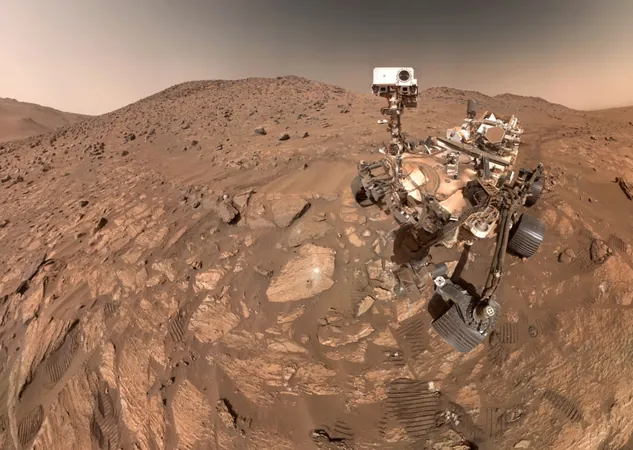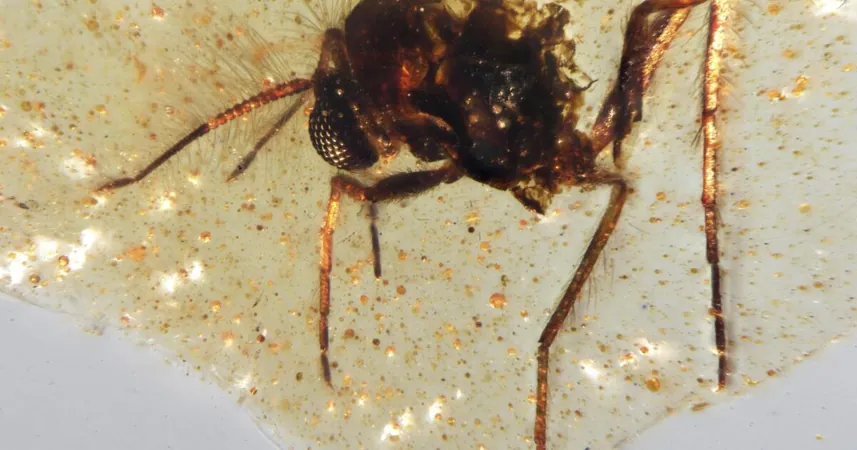
NASA's Perseverance Rover Unveils Potential Signs of Life on Mars!
2025-09-21
Author: Benjamin
A Groundbreaking Discovery on the Red Planet
In a stunning revelation, NASA's Perseverance rover has brought the possibility of ancient microbial life closer to reality. A year after it drilled into a Martian rock named Cheyava Falls, scientists announced that the collected sample, dubbed Sapphire Canyon, may hold a chemical signature indicative of life.
This exciting finding has been hailed as the closest we’ve come to proving life exists beyond Earth, according to a publication in the journal Nature.
Mars' Ancient River Valley: A Potential Treasure Trove
Perseverance stumbled upon the Cheyava Falls outcrop in July 2024 while investigating the Bright Angel formation, part of a vast network of rocky layers lining the edges of Neretva Vallis. This area, billions of years ago, served as a river valley that fed a significant lake inside what is now Jezero Crater.
The sedimentary rocks found here are rich in clay, silt, and organic carbon—elements that typically preserve microbial remains exceptionally well on Earth. These rocks also contain sulfur, oxidized iron, and phosphorus, all of which could have served as energy sources for primitive life.
Intriguing Discoveries in Martian Mudstone
The Perseverance rover has made even more fascinating finds, such as the peculiar “leopard spots” in the Cheyava Falls rock formations. Utilizing its advanced tools, PIXL and SHERLOC, the rover detected striking color patterns across the rock's surface. These spots consist of two iron-based minerals, vivianite and greigite, which could suggest biological activity.
On Earth, vivianite often emerges in sediments where organic matter decays, while greigite can be produced by certain microbes. These minerals hint at electron-transfer reactions akin to those that sustain microbial life.
Rethinking Mars' Habitability
Astrobiologists have long considered Jezero Crater a prime site for finding signs of life, but new evidence indicates that Mars might have been habitable much more recently than initially thought. “This could be a potential fingerprint of microbial life,” explained Joel Hurowitz, the lead author of the research published in Nature, although he tempered excitement by noting that compelling chemistry alone doesn’t confirm life.
The Road Ahead: Mars Sample Return Mission
Perseverance has gathered a total of 27 rock cores since landing in Jezero Crater in 2021, storing them in cylindrical tubes for potential return to Earth. NASA’s instruments are designed to detect possible biosignatures, but the ultimate validation will occur via Earth-based laboratories.
According to Katie Stack Morgan, project scientist for Perseverance, “We’ve thrown the entire rover payload at this rock. We’re limited in what Perseverance can achieve on the surface; the next steps depend on transporting these samples home.”
A Quest for Answers: Are We Alone?
The identification of leopard spots in Martian mudstone isn’t merely a mineral matter; it taps into humanity’s fundamental question: Is there life beyond our planet? Acting NASA Administrator Sean Duffy called the finding a milestone, stating, “This is the closest we have ever come to discovering life on Mars. The potential identification of a biosignature represents a groundbreaking discovery.”
While excitement is in the air, caution persists in the scientific community. The leopard spots might be the most compelling hints of life on Mars, but only laboratory tests on Earth can confirm if these signs are biological or merely geological.
What Lies Ahead for Perseverance
As Perseverance continues its journey through Jezero Crater, each new core sample brings scientists closer to unlocking ancient Martian secrets. If the rocks from Sapphire Canyon do indeed contain biosignatures, this could mark humanity’s first confirmed evidence of extraterrestrial life—a discovery that would forever alter our understanding of our place in the universe.
For now, the samples await their fate in metal tubes, silent messengers from the Red Planet, holding secrets that could change everything we know.









 Brasil (PT)
Brasil (PT)
 Canada (EN)
Canada (EN)
 Chile (ES)
Chile (ES)
 Česko (CS)
Česko (CS)
 대한민국 (KO)
대한민국 (KO)
 España (ES)
España (ES)
 France (FR)
France (FR)
 Hong Kong (EN)
Hong Kong (EN)
 Italia (IT)
Italia (IT)
 日本 (JA)
日本 (JA)
 Magyarország (HU)
Magyarország (HU)
 Norge (NO)
Norge (NO)
 Polska (PL)
Polska (PL)
 Schweiz (DE)
Schweiz (DE)
 Singapore (EN)
Singapore (EN)
 Sverige (SV)
Sverige (SV)
 Suomi (FI)
Suomi (FI)
 Türkiye (TR)
Türkiye (TR)
 الإمارات العربية المتحدة (AR)
الإمارات العربية المتحدة (AR)